Mark Sisson's Blog, page 46
June 3, 2021
Want to Accelerate Your Results? Set Up Your Environment for Success
 I’m a huge fan of keeping things simple (I even put it in my business name: eat.simple). I especially feel this way when it comes to food, fitness, and fat loss. If you’re sick of white knuckling it through your day, struggling with non-existent motivation, or the phrase “I’ll just start again on Monday” is on regular rotation in your vocabulary, there’s one life-changing tactic I use with all my clients that’s proven to accelerate results.
I’m a huge fan of keeping things simple (I even put it in my business name: eat.simple). I especially feel this way when it comes to food, fitness, and fat loss. If you’re sick of white knuckling it through your day, struggling with non-existent motivation, or the phrase “I’ll just start again on Monday” is on regular rotation in your vocabulary, there’s one life-changing tactic I use with all my clients that’s proven to accelerate results.
I realize life-changing is a fairly dramatic word, but without this one step, you’ll be working harder than you need to. The simplest and most impactful thing you can do to accelerate your results is to set your environment up for success.
The Role Your Environment PlaysThink about the unfavourable snack foods that you keep in your pantry. You know, “just in case.” Or the fact that you have no clue where you put those free weights you bought during the pandemic.
Does that get you closer to your results or further away?
When you remove the foods that tempt you from the house and replace them with ones that support your goal, you have the best possible chance of succeeding. Same goes for exercise. If your workout gear is tucked away in a back closet, how likely are you to use it?
Environment is the invisible hand that shapes human behaviour.
This nugget of truth from author and habit expert, James Clear is 100% spot on. People tend to believe that their healthy habits are a product of motivation, willpower, and effort, when in reality, it’s your environment that gives you the biggest bang for your buck. Clear says, “If you want to maximize your odds of success, then you need to operate in an environment that accelerates your results rather than hinders them.”
Examples of how environment impacts you:
Your phone is right next to your desk, so you check Instagram more often than you’d likeYou didn’t make time to go grocery shopping, so it looks like it’s take-out again tonightThe room you work out in is cluttered with junk, making it hard to find space to do yogaYou use a large dinner sized plate, and fill it up with more food than you needYou keep ice cream in the freezer and eat it after a really stressful dayChange Your Environment, Change Who You AreEnvironment plays a big role in your ability to reach your goals. Not just from a conscious perspective (remove the ice cream from the freezer so it’s harder to indulge), but also from a subconscious perspective.
By altering your environment, your subconscious mind starts to adopt behaviours and attitudes that are conducive to your success. Say, you went ahead and purged all the cookies, bagels, muffins, and cereal from your pantry and replaced them with bowls of fresh fruit and veggies. The food you’re surrounded by begins to change the way you think about yourself.
In other words, if your cupboard is filled with processed, sugary foods, you’re more apt to think of yourself as someone who eats those types of foods. You might also believe you’re someone with no willpower or destined to always have cravings. FYI, you might want to look into your limiting beliefs here.
In contrast, if you had fresh produce at arm’s reach (and eye level), you’d likely start to believe you’re someone who enjoys eating real, whole food that supports your body. Someone who likes to get outside for fresh air. Someone who can stay on track more easily and totally crush their goals.
Make Healthy Choices EffortlessMassachusetts General Hospital physician, Anne Thorndike, was curious if environment could affect people’s eating behaviours at her hospital, so she and her team created an experiment they called, “choice architecture.”https://www.ncbi.nlm.nih.gov/pmc/arti... In the experiment, they arranged the cafeteria’s refrigerators so that water and other healthier drinks were located at eye level, while less healthy options like soda were placed below eye level. They also added five baskets of bottled water throughout the cafeteria near the food stations.
After tracking sales for three months, they discovered that soda purchases had dropped 11.4% and bottled water sales had increased by a whopping 25.8%. And that was with no other external influence or motivational factors. Simply by moving the preferred choice to a different location, people chose it more often than the less-healthy option.
A Guide to Setting Yourself Up for SuccessOur daily lives are made up of a lot of the same habits: Wake up, brush teeth, grab a fruit-on-the-bottom yogurt and glass of OJ — or skip breakfast and treat your not-quite-fat-adapted self to a sugar bomb once you get into work. Want to change your programming (and your go-to food choices)? You have to change your environment.
Make What You Want to Do Easy. When something is easy to do, there’s less resistance (and less procrastination). That workout program you never started will be much more effective if you set your space up appropriately. Place some dumbbells next to your desk and do a set of curls every time you get up. Or put your running shoes next to the front door, so you’re more likely to lace up and go for a walk when you see them.Make What You Don’t Want to Do Hard. If your brain knows that there are crunchy, salty, starchy, fatty, sweet, sticky, snacky (probably junky and highly processed) foods in the house, you will eat them. You are wired to devour these foods. So why tempt yourself with them all day, every day? Get them out of the house. Or better yet, only buy them on special occasions and preferably in smaller quantities.Eliminate Extra Decisions. Decision fatigue is a very real psychological phenomenon around a person’s capacity to make decisions. The more decisions you need to make, the more fatigued your brain becomes, and the poorer your choices will be.Decision fatigue explains why you buy the Costco-sized bag of chips when you’d just declared all processed food off the table. And it explains your ‘do nothing’ mentality when you have the choice of going for a run or vegging out in front of the TV. Eliminate unnecessary decisions by prepping your lunch ahead of time or getting your daily walk out of the way first thing in the morning.Stack Your Habits. Think about your no-brainer habits: brewing a cup of coffee, taking your shoes off, watching TV, etc. Your brain is very efficient at remembering to do these things and one of the best ways to set your environment up for success by stacking new habits on top of existing ones. You could decide that every morning after you pour your cup of coffee, you meditate for 5 minutes. Or you immediately change into workout clothes after taking off your shoes at the end of the day. Or you do planks during the commercial breaks.Surround Yourself with Like-Minded People. Studies show that we reflect the behaviours of the people around us. That means it’s crucial that your people are supportive, inspiring, and most importantly aren’t destructive, negative, or have the tendency to sabotage you. You’re the average of the five people you associate with most, so don’t underestimate the effects of your pessimistic, unambitious, or disorganized friends. Like Tim Ferriss says, “If someone isn’t making you stronger, they’re making you weaker.”Ready to Fast-Track Your Results?You can’t ignore the fact that your environment influences your decisions, your behaviours, and even your attitude. If you want to accelerate your results — whether it’s losing fat, getting in shape, or preventing procrastination, follow these steps to create an environment that supports your goals, rather than works against them:
Make What You Want to Do EasyMake What You Don’t Want to Do HardEliminate Extra DecisionsStack Your HabitsSurround Yourself with Like-Minded PeopleGot tips on setting your environment up for success? Share ‘em in the comments below.
(function($) { $("#df7a1iM").load("https://www.marksdailyapple.com/wp-ad..." ); })( jQuery );
References https://www.ncbi.nlm.nih.gov/pmc/articles/PMC3329221/
The post Want to Accelerate Your Results? Set Up Your Environment for Success appeared first on Mark's Daily Apple.



June 2, 2021
The Definitive Guide to FODMAPs
 You could be having a fairly routine conversation about health and nutrition where everything discussed is familiar. You hear things like “carbs” and “medium chain triglycerides” and “fructose” and “macros” and “gluten” and “PUFAs,” thinking nothing of it. Like I said, routine. Then someone mentions FODMAPs. Huh? What the heck is that? Quite possibly one of the strangest, seemingly contrived acronyms in existence, FODMAPs represents a collection of foods to which a surprisingly large number of people are highly sensitive. To them, paying attention to the FODMAPs in their diets is very real and very serious if they hope to avoid debilitating, embarrassing, and painful digestive issues.
You could be having a fairly routine conversation about health and nutrition where everything discussed is familiar. You hear things like “carbs” and “medium chain triglycerides” and “fructose” and “macros” and “gluten” and “PUFAs,” thinking nothing of it. Like I said, routine. Then someone mentions FODMAPs. Huh? What the heck is that? Quite possibly one of the strangest, seemingly contrived acronyms in existence, FODMAPs represents a collection of foods to which a surprisingly large number of people are highly sensitive. To them, paying attention to the FODMAPs in their diets is very real and very serious if they hope to avoid debilitating, embarrassing, and painful digestive issues.
FODMAPs are carbohydrates and fibers that gut bacteria can ferment in the gut and cause excessive gas, intestinal discomfort, diarrhea, and/or constipation. In other words, FODMAPs are a potential source of digestive distress in susceptible people.
What does FODMAP stand for?FODMAP is an acronym. F is for Fermentable carbohydrates that gut bacteria ferment. O is for Oligosaccharides, chains of carbohydrates. D is for disaccharides, pairs of sugar molecules. M is for monosaccharides, single sugar molecules. P is for Polyols, or sugar alcohols.
F is for Fermentable – Fermentable carbohydrates are carbohydrates that are fermented by bacteria instead of broken down by our digestive enzymes. In most people, some fermentable carbohydrates are healthy sources of food for the (helpful) bacteria that ferment them; these can include the prebiotics I’ve championed in the past and can actually improve digestive and overall health. In people with FODMAPs intolerance, certain carbohydrates can become too fermentable, resulting in gas, bloating, pain, and poor digestion, as well as proliferation of unwanted pathogenic bacteria.
O is for Oligosaccharides – Oligosaccharides are short-chain carbohydrates, including fructans (fructooligosaccharides, or FOS, and inulin) and galactans (raffinose and stachyose). Fructans are chains of fructose with a glucose molecule at the end; galactans are chains of galactose with a fructose molecule.
D is for Disaccharides – These are pairs of sugar molecules, with the most problematic being the milk sugar lactose (a galactose molecule with a glucose molecule).
M is for Monosaccharides – This describes a single sugar molecule. Free fructose is the monosaccharide to watch out for with FODMAPs intolerance.
A is for And – Every list needs a good conjunction.
P is for Polyols – Polyols include sugar alcohols like xylitol, sorbitol, or maltitol. For an idea as to their effects, type one of them into Google and note the autofill choice (hint: it’s usually “diarrhea” or “constipation” or “gas”). Since large amounts of polyols rarely occur in nature, lots of people have trouble with them.
Most people probably don’t need to worry about these categories. Most people enjoy pristine, effortless trips to the toilet that happen like clockwork and finish in under a minute. Heck, as I understand it, most people don’t even use toilet paper these days; they are that efficient and clean. Yes, it’s true: digestion worldwide has never been better!
The reality, of course, is that digestive difficulties are widespread, particularly in the industrialized world. If it’s not constipation, it’s diarrhea. Or bloating. Or gas. Or hemorrhoids. Or IBS (irritable bowel syndrome). Or all of the above. These complaints are sadly very common (even more common than those stats would suggest, since many people are too embarrassed to admit they have an issue). For many of these people, FODMAPs may be exacerbating their symptoms.
Why are FODMAPs an Issue for Some People?
Normal carbohydrate digestion takes place in the small intestine, where polysaccharides are broken up into glucose, fructose, and galactose and transporters like GLUT2 and GLUT5 absorb them for the body to use as nutrients. Sometimes those sugar molecules make it past the small intestine into the large intestine where colonic bacteria – the gut flora we (sorta) know and love – gobbles it up via fermentation, potentially causing gas and painful bloating. The presence of too many sugars in the colon can also cause an influx of fluid, which could lead to diarrhea. Constipation is another common symptom, though it’s not clear exactly how FODMAPs cause it. And some polysaccharides, like the oligosaccharides, make it through to the colonic bacteria as a rule because they resist digestion in everyone (in healthy people, these have a useful prebiotic effect).
You might be thinking, “Cool, so I can just avoid those weird sounding sugars and be fine, right?” Probably not. FODMAPs are very prevalent in the food supply. Even if you avoid free fructose, don’t drink milk, and ditch processed food containing sugar alcohols, you’ll still run into them in many fruits and vegetables.
Now, FODMAPs aren’t an issue for many people. They’re either digested normally or their gut bacteria are sufficiently diverse and healthy that they can benefit from the prebiotic input. But for those who can’t digest them properly, they should be aware of high- and low-FODMAP foods.
What are High-FODMAP Foods?The highest FODMAP foods include fibrous fruits and vegetables, fruits and other foods that have concentrated levels of fructose and sugar, processed foods full of sugar alcohols, concentrated sources of sugar like plain sugar, honey, juice, and soda, and grains full of insoluble fiber.
Okay, just so you know what you’re dealing with, here’s a big list of all the foods that are high in FODMAPs including which FODMAP they contain.
FODMAP vegetables:Asparagus (fructose, fructans)Artichoke (fructose)Beets (fructans)Broccoli (fructans)Brussels sprouts (fructans)Butternut squash (fructans)Cabbage (fructans)Celery (polyols)Cauliflower (polyols)EggplantFennel (fructans)Garlic (fructans)Jerusalem artichoke/fartichoke (fructan)Jicama (fructan)Leek (fructans)Mushroom (polyol)Okra (fructans)Onion (fructans)Shallots (fructans)Sweet corn (fructose)Radicchio (fructans)Sweet potato (polyol)FODMAP FruitsApples (fructose, polyol)Apricots (polyol)Avocados (polyol)Blackberries (polyol)Cherries (fructose, polyol)Plums (polyol)Pluots (polyol)Lychees (polyol)Nectarines (polyol)Peaches (polyol)Pears (fructose, polyol)Persimmons (polyol)Mango (fructose)Watermelon (polyol, fructose)Dried fruit (fructose)Juice (fructose)Other FODMAP FoodsHoney (fructose)Agave nectar (fructose)White sugar (fructose)Maltitol, sorbitol, mannitol, xylitolDairy that contains lactose, like milk, cream, butter, and soft cheesesWheat, barley, rye, spelt, emmer, einkorn, oatsLentils and beansAlmonds, cashews, pistachiosWhat are Low-FODMAP Foods?Low-FODMAP foods include meat of all kinds, poultry, seafood, fish, shellfish, eggs, and hard low-lactose cheeses. Low-fiber vegetables, fruits, and nuts also tend to be lower in FODMAPs than more fibrous fruits, vegetables, and nuts; fermentation also reduces FODMAP content.
If you suspect you have digestive issues and want to try a low-FODMAP diet, here’s an exhaustive list of what you can eat.
Animal FoodsMeat of all kinds: beef, lamb, pork, goat, game meats. They’re all completely free of FODMAPs.Poultry: name a bird and it’s FODMAP-free.Seafood, fish, and shellfish are also FODMAP-free.Eggs contain no FODMAPs.Hard cheeses, sour yogurts and kefirs are very low in FODMAPs.VegetablesZucchiniSquashPotatoesSpinachKaleLettuces of all kindsArugulaGreen beansCollard greensMustardPumpkinSeaweedTurnipsRutabagasCucumbersChilisFermented or pickled vegetables are low in FODMAPs, often even when the fresh versions are high. So pickled beets or sauerkraut will be lower in FODMAPs than fresh beets and fresh cabbage.FruitsMelons (except for watermelon)Bananas (except if green)StrawberriesBlueberriesOrangesGrapesPineappleKiwiRaspberriesGrainsRiceBuckwheat (technically a pseudocereal but close enough to count)AmaranthQuinoaTeffAny fermented grain (sourdough) will be lower in FODMAPs than the same unfermented grain. Sourdough bread is much lower in FODMAPs than unfermented bread, for example.NutsMac nutsWalnutsBrazil nutsChestnutsPeanuts (yeah, yeah, I know it’s a legume)Let me reiterate before I go on, because I don’t want to scare everyone away from berries and broccoli: not everyone has problems with FODMAPs. Most people probably don’t. If you’re eating all that stuff without issue, continue doing so and consider this post merely an academic curiosity. They are largely healthy foods that provide prebiotic substrate for your healthy gut bacteria to thrive on.
Is the Low-FODMAP Diet an Irritable Bowel Syndrome Diet?Low-FODMAP diets beat the pants off conventional dietary advice for people with IBS.https://www.ncbi.nlm.nih.gov/pubmed/2... One study found that while healthy subjects had increased flatulence on a high-FODMAP diet, subjects with IBS had increased flatulence in addition to lethargy and gut pain.https://www.ncbi.nlm.nih.gov/pubmed/2... This could indicate that both groups were feeding FODMAPs to their gut bugs (which produce the flatulence through fermentation), but only the IBS patients had enough pathogenic gut flora to produce adverse symptoms. Farts are funny. Bloating and severe pain are not.
Who else might benefit from limiting FODMAPs?Anyone with small intestinal bacterial overgrowth (SIBO).Normally, the small intestine has relatively low numbers of gut flora residents. In SIBO, it’s got tons that aren’t supposed to be there. They interfere with nutrient absorption, digestion, and just generally muck everything up. SIBO has been shown to correlate quite strongly with lactase deficiency.https://www.ncbi.nlm.nih.gov/pubmed/2... Without enough lactase, you won’t be able to digest lactose (one of the premier FODMAPs) and your colonic bacteria will have to do the job. Another, earlier study found that patients with SIBO also show malabsorption of fructose and sorbitol in addition to lactose; all three are FODMAPs.https://www.ncbi.nlm.nih.gov/pubmed/1...
Anyone suffering from chronic stress.Stress is a well-known disruptor of digestive function as anyone who’s gotten queasy, lost their appetite, or had explosive diarrhea before the big interview could tell you. There’s evidence that stress might be causing FODMAP-intolerance, too. First, stress inhibits the action of GLUT2, a transporter responsible for the small intestinal absorption of glucose, fructose, and galactose in the gut.https://www.ncbi.nlm.nih.gov/pubmed/1... If you’re unable to adequately absorb the sugar molecules in the small intestine, they end up making it to your large intestine for fermentation by colonic bacteria. Second, stress has an immediate impact on the composition and function of your gut flora, rendering your populations less diverse and allowing certain pathogenic species to overpopulate—species that feed on FODMAPs.
Anyone who thinks they’re gluten-sensitive.Since gluten-containing grains also tend to be high in FODMAPs, many people who think they have gluten-sensitivity or celiac disease actually are just sensitive to the FODMAPs in the wheat, rye, or barley. Ask your doctor about testing for celiac, SIBO, and other digestive disorders.
Anyone with otherwise unexplained digestive problems.Maybe you haven’t had a diagnosis. Maybe you just don’t feel right after eating almost anything. Maybe you’re chronically constipated (or the opposite). Trying a low-FODMAP diet can help you narrow your focus and start to identify some culprits.
How to Try a FODMAP Elimination DietIf you decide you might be a good candidate for a low-FODMAP diet, try a FODMAP elimination diet trial. Go through the list of FODMAP foods from this article and eliminate the ones high in FODMAPs and limit your diet to the ones low in FODMAPs. If your symptoms improve, add FODMAP foods back into your diet one by one every three or four days to track which ones cause your symptoms. Consider keeping a diet journal to log your food and track your reactions to individual FODMAPs. Some people might really react poorly to fructose while having no issues with lactose. Point being: different FODMAPs affect different people differently. You can tolerate some and not others. And if you can tolerate them, they’re worth consuming.
Dosage matters, too. A gram of inulin might be fine, while five grams could cause distress. A half cup of blackberries might be fine while a full cup gives you bloating. Individual tolerance must be determined by, well, seeing what and how much you tolerate.
If you’re interested in healing your gut, whether from SIBO or IBS or anything else that might be predisposing you to FODMAP intolerance, well-established protocol like GAPS (Gut and Psychology Syndrome) diet or SCD (specific carbohydrate diet) may help and are worth looking into.
Another good low-FODMAP diet to try is the carnivore diet. By virtue of eliminating all plant foods, it eliminates the vast majority of FODMAP foods. Read here for a good take on carnivore.
If you have no digestive issues, I would caution against trying a low-FODMAP diet “just because.” You’ll be missing out on some very nutritious, important foods, probably unnecessarily, while adding a bunch of unnecessary stress to your eating. FODMAP-related digestive issues are very noticeable. You’ll know it if you have it.
Well, that about sums it up. I hope this Definitive Guide to FODMAPs was helpful for you.
Now that we’re done, what about you? Do you have any sensitivities to FODMAPs? Has looking at that list of FODMAP foods made lightbulbs go off? Let me know below!
(function($) { $("#dfPPWZ8").load("https://www.marksdailyapple.com/wp-ad..." ); })( jQuery );
The post The Definitive Guide to FODMAPs appeared first on Mark's Daily Apple.



June 1, 2021
3 Breathing Exercises to Improve Vagal Tone and Reduce Stress in a Flash
 Cranial nerve X. It sounds like a pretty rad superhero, or maybe the superhero’s genius sidekick who comes up with all the cool gadgets and never gets credit for being the one who actually foils the villain’s evil plans.
Cranial nerve X. It sounds like a pretty rad superhero, or maybe the superhero’s genius sidekick who comes up with all the cool gadgets and never gets credit for being the one who actually foils the villain’s evil plans.
Cranial nerve X, aka cranial nerve 10, aka the vagus nerve, is neither of those things, but it IS pretty rad. The vagus nerve is a cranial nerve complex that runs from the base of the brain down through your trunk, branching out like a tree and sending “roots” out to communicate with your internal organs and glands.https://pubmed.ncbi.nlm.nih.gov/11189... When we talk about the undeniable power of the mind-body connection, we’re usually referring to the vagal nerve’s actions.
What Is the Vagus Nerve?The vagus nerve is the core of your parasympathetic nervous system. You might remember that your nervous system comprises two parts: the sympathetic “fight-flight-freeze” nervous system and the parasympathetic “rest-and-digest” nervous system. Well, you can’t rest and digest without the vagus nerve. Think of it as an information superhighway. It collects information from your organs and translates it into messages that tell the brain, “Everything is cool down here!” or “Yikes, something bad is going down! Time to get the sympathetic nervous system involved.” It also carries directives from the brain to the body.
To put it simply, the vagus nerve modulates the stress response and facilitates our ability to maintain homeostasis. Some people describe the vegaus nerve as a “brake” on the sympathetic nervous system, but I don’t care for that analogy. It implies that when you’re in fight-flight-freeze mode, you’re “on,” and when you’re highly parasympathetic (resting and digesting), you’re off.
That’s not accurate. All the good stuff—growth, repair, emotion regulation, social connectivity—happens in parasympathetic mode. You definitely want to be parasympathetic dominant or vagal dominant.
Vagal Tone
The term vagal tone refers to how active the vagus nerve is, which is an index of parasympathetic nervous system activity. Higher vagal tone = more parasympathetic = less physiologically stressed.
Heart rate variability (HRV) is an indicator of vagal tone, with higher HRV correlating to higher vagal tone. Decreases in heart rate, respiratory rate, and blood pressure all indicate increased parasympathetic nervous system activity, so they can also be proxies for vagal tone. Any practices that increase HRV or lower one of those cardiorespiratory markers increase vagal tone.
Research is showing that we can intentionally activate the vagus nerve and thereby alleviate physiological stress. One of the simplest ways to do so is by modulating our breathing. It sounds too good to be true, but you can literally affect your biochemistry almost instantaneously by changing your breath. Breathwork is becoming more popular in the health, fitness, and longevity spheres. With it, we’ll see a growing interest in the vagus nerve and how we can hack it to relieve the chronic stress endemic to modern life.
I’m making my prediction now: the vagal nerve is poised to have its own hot girl summer, and I, for one, am looking forward to it.
3 Breathing Exercises to Increase Vagal ToneThe vagus nerve relays information between the brain and the lungs to regulate breathing.https://www.ncbi.nlm.nih.gov/pmc/arti... When you aren’t stressed, your breathing is naturally slow and controlled. Your heart rate also increases with each inhalation and, thanks to the vagus nerve, slows down with each exhalation, a phenomenon called respiratory sinus arrhythmia.https://pubmed.ncbi.nlm.nih.gov/14769...
Normally, these are top-down, or efferent, processes, meaning the brain controls these physiological processes via the vagus nerve. However, there is also a growing body of evidence showing that when we consciously breathe as if we are unstressed, we can essentially tell the vagus nerve that we are, in fact, relaxed.https://www.ncbi.nlm.nih.gov/pmc/arti... The vagus nerve then sends that info to the brain, and voilà, we’ve created our own chilled-out reality.
Those of you with little kids might remember the lesson from Daniel Tiger:
When you feel so mad
That you want to roar
Take a deep breath
And count to four
Daniel’s offering some smart, science-backed advice there. That deep breath calms the body and changes your emotional response to a negative situation. Any time you pause and take a few slow, calming breaths, you activate the vagus nerve and put yourself in a more parasympathetic state.https://www.ncbi.nlm.nih.gov/pmc/arti...
In the longer term, it seems possible to improve vagal tone and put yourself in a more chronic parasympathetic-dominant state with regular breathwork practices. Here are three to try:
Diaphragmatic Breathinghttps://pubmed.ncbi.nlm.nih.gov/14572... https://pubmed.ncbi.nlm.nih.gov/19629... https://pubmed.ncbi.nlm.nih.gov/20954...Diaphragmatic breathing entails taking slow, deep, belly breaths. Find a comfortable position, either lying down with your knees bent or seated with your feet on the ground. Place one hand on your chest and the other on your belly.
Inhale slowly through your nose. As you do, you should feel the hand on your belly rise. Exhale gently and feel your belly fall. Think about the air coming in through your nose and all the way into your belly, then up and out again in a smooth wave.
If most of the movement of your breath is in your chest or, worse, your shoulders, that means you aren’t really engaging your diaphragm to pull the air into your body. Keep practicing!
Resonance Breathinghttps://www.ncbi.nlm.nih.gov/pmc/arti... https://pubmed.ncbi.nlm.nih.gov/24380...Resonance breathing, also called coherent breathing, means breathing at a rate that allows your breath and heart rate to synchronize. Although we each have slightly different resonant frequencies, research has shown that the average resonance is approximately 5.5 breaths per minute, which works out to 5.5 seconds for each inhale and 5.5 seconds exhale. Cool, right?
According to James Nestor, author of Breath, many traditional religious chants and prayers from around the world had a similar rhythm that would naturally cause people to breathe about 5.5 times per minute.https://www.ncbi.nlm.nih.gov/pmc/arti... This offers a physiological explanation for how prayers, chants, and yogic mantras exert a calming effect.
To practice resonance breathing on your own, find a comfortable position seated or lying down. Take a few slow breaths to calm and center yourself, then begin inhaling for a count of five and exhaling for a count of five. Concentrate on the rhythm of your breathing.
Extended Exhalehttps://pubmed.ncbi.nlm.nih.gov/25156... https://pubmed.ncbi.nlm.nih.gov/30826...Extended exhale breathing patterns take advantage of the aforementioned respiratory sinus arrhythmia. The vagus nerve is activated during exhalation, so extending the exhale can provide “respiratory biofeedback” and tell the brain you are relaxed.https://www.ncbi.nlm.nih.gov/pmc/arti...
There’s not enough research to pinpoint an optimal ratio, but I’ve seen both 4:8 and 4:10 recommended. That means inhaling for four seconds, pausing, then exhaling for eight to ten seconds. It probably doesn’t matter which you do, as long as the exhalation is longer than the inhale. If this is too challenging to start, try a three-second inhalation and a seven-second exhalation.
Putting These Breathing Exercises into PracticeYou can perform these exercises anytime, anywhere. Next time you’re feeling stressed while stuck in traffic or the slowest line at the grocery store, try inhaling for four seconds and exhaling for eight seconds. See if you don’t start to feel calmer almost immediately.
Ideally, you should make breathwork a consistent practice, much like meditation. In fact, breathwork is a form of meditation. Pick one of the exercises above and start by doing one or two five-minute sessions each day. If you can do ten minutes, all the better. Work up to longer sessions, up to twenty or thirty minutes once or twice a day. Try breathing through your nose as much as possible.
If that sounds like a lot, start with what you can do. You’ll probably find that you’ll start to crave the benefits. As you start to improve vagal tone and experience more calm, less stress, and better emotion regulation, it becomes self-reinforcing. You want more.
The good news is it’s likely that many of the foundational Primal lifestyle behaviors also improve vagal tone. That’s likely one pathway by which they improve health and wellbeing. Stay tuned for part two of this series, where I’ll talk about how this might work. It’s very rad indeed!
References https://pubmed.ncbi.nlm.nih.gov/11189015/https://www.ncbi.nlm.nih.gov/pmc/articles/pmc4842319/https://pubmed.ncbi.nlm.nih.gov/14769752/https://www.ncbi.nlm.nih.gov/pmc/articles/PMC6189422/https://www.ncbi.nlm.nih.gov/pmc/articles/PMC5709795/https://pubmed.ncbi.nlm.nih.gov/14572682/https://pubmed.ncbi.nlm.nih.gov/19629309/https://pubmed.ncbi.nlm.nih.gov/20954960/https://www.ncbi.nlm.nih.gov/pmc/articles/PMC5575449/https://pubmed.ncbi.nlm.nih.gov/24380741/https://www.ncbi.nlm.nih.gov/pmc/articles/PMC61046/https://pubmed.ncbi.nlm.nih.gov/25156003/https://pubmed.ncbi.nlm.nih.gov/30826382/https://www.ncbi.nlm.nih.gov/pmc/articles/PMC6189422/The post 3 Breathing Exercises to Improve Vagal Tone and Reduce Stress in a Flash appeared first on Mark's Daily Apple.



May 29, 2021
Italian Chicken and Basil Kabobs Recipe, Because Everything Tastes Best on Skewers
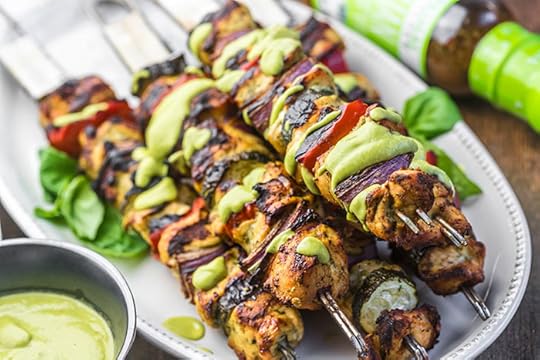 Kabobs typically have a warm-spiced Middle-eastern or a sweet Hawaiian flair. We’re changing it up and marinating our chicken kabobs in your favorite Italian flavors, like garlic, basil, lemon, and an herby marinade. You’re going to love this spin on the traditional meat-and-veggie-on-a-stick experience.
Kabobs typically have a warm-spiced Middle-eastern or a sweet Hawaiian flair. We’re changing it up and marinating our chicken kabobs in your favorite Italian flavors, like garlic, basil, lemon, and an herby marinade. You’re going to love this spin on the traditional meat-and-veggie-on-a-stick experience.
Getting together for backyard barbecues again? These Italian chicken and basil kabobs make a showstopping entreé that will wow the entire patio with its jewel-toned vegetables and its flavorful marinade.
We could talk about grilled chicken kabobs all day, but we’d rather make them (and eat them!). Here’s how to do it.
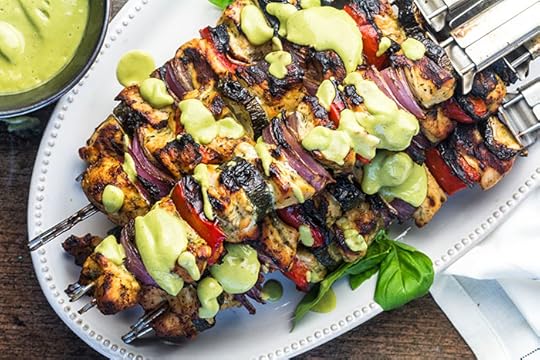
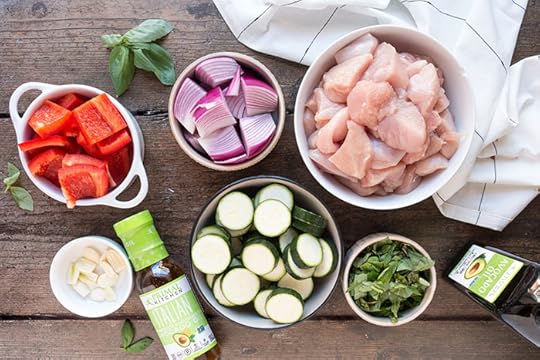
Combine the Primal Kitchen Italian dressing, basil and garlic in a blender until smooth.
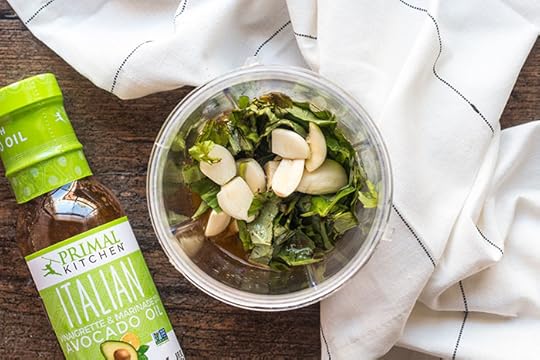 Mix ? of the sauce with the chicken and place it in the fridge for about an hour to marinate (or longer if you like).
Mix ? of the sauce with the chicken and place it in the fridge for about an hour to marinate (or longer if you like).

Toss the chopped bell pepper, zucchini and onion in the avocado oil and a pinch of salt and pepper.
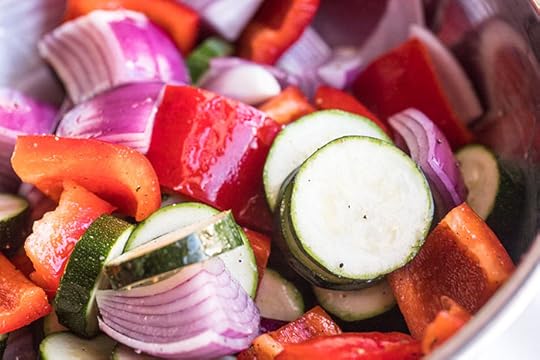
Once the meat has marinated, thread the skewers with alternating meat and vegetables in whatever pattern you’d like.

Preheat your grill to medium-high heat. Once hot, place the skewers on the grill. Turn them over every few minutes, covering the grill when you’re not turning them. Continue grilling until the internal temperature of the chicken reaches 165 degrees Fahrenheit.
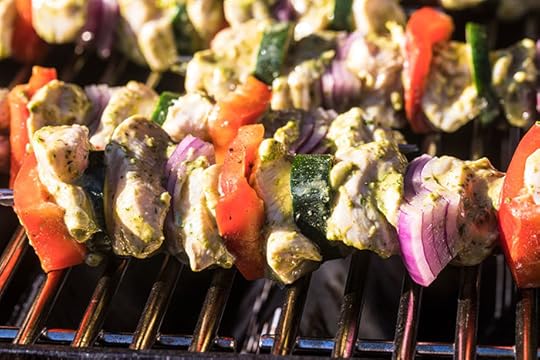
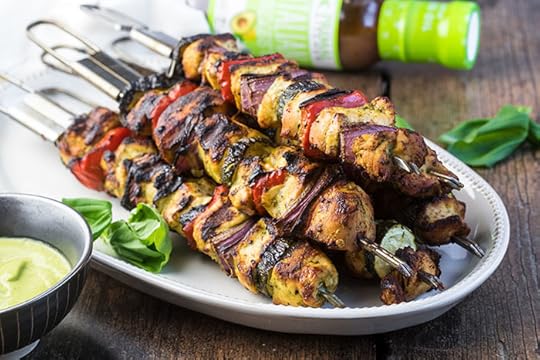
Take the remaining Italian basil sauce in the blender and add the lemon juice and avocado to it. Blend until smooth and season with salt and pepper.
Serve your skewers with some of the avocado sauce on top and the rest on the side. Enjoy!

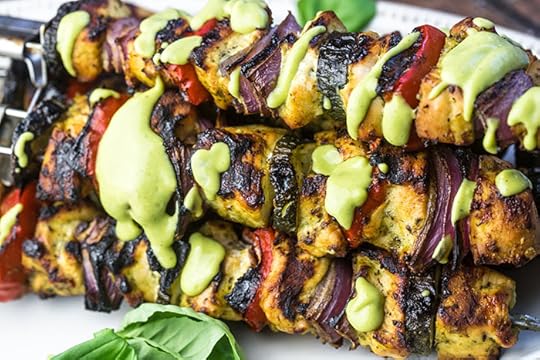

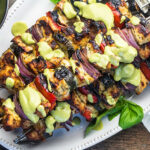 Italian Chicken and Basil Kabobs Recipe, Because Everything Tastes Best on Skewers Author: Mark's Daily Apple
Italian Chicken and Basil Kabobs Recipe, Because Everything Tastes Best on Skewers Author: Mark's Daily Apple  Prep Time: 10
Prep Time: 10  Cook Time: 15
Cook Time: 15  Total Time: 25 minutes
Total Time: 25 minutes  Yield: 6 kabobs
Yield: 6 kabobs  Print Recipe
Print Recipe  Pin Recipe Description
Pin Recipe Description Italian spiced grilled chicken kabobs with garlic, basil, and vegetables
Ingredients2 lbs. Boneless chicken breast, cut into 1” chunks
1 large red bell pepper cut into chunks
2 medium zucchini, cut into rounds
1 large red onion, cut into chunks
½ cup Primal Kitchen Italian Dressing and Marinade
¾ cup fresh basil leaves
2 cloves garlic
2 tbsp. Primal Kitchen Avocado Oil
½ avocado
1 tbsp. lemon juice
water
Salt and pepper
Combine the Primal Kitchen Italian dressing, basil and garlic in a blender until smooth. Mix ? of the sauce with the chicken and place it in the fridge for about an hour to marinate (or longer if you like).
Toss the chopped bell pepper, zucchini and onion in the avocado oil and a pinch of salt and pepper.
Once the meat has marinated, thread the skewers with alternating meat and vegetables in whatever pattern you’d like.
Preheat your grill to medium-high heat. Once hot, place the skewers on the grill. Turn them over every few minutes, covering the grill when you’re not turning them. Continue grilling until the internal temperature of the chicken reaches 165 degrees Fahrenheit.
Take the remaining Italian basil sauce in the blender and add the lemon juice and avocado to it. Blend until smooth and season with salt and pepper.
Serve your skewers with some of the avocado sauce on top and the rest on the side. Enjoy!
NotesIf you are using wooden skewers, soak them for 30 minutes prior to placing the meat and veggies on them.
This recipe would also work well with beef – you can try sirloin or ribeye and cut them into 1” cubes prior to marinating.
Nutrition Serving Size: 1 kabob Calories: 324.9 Sugar: 11.2 g Sodium: 378.7 mg Fat: 20.4 g Saturated Fat: 5.1 g Unsaturated Fat: 13.7 g Trans Fat: .1 g Carbohydrates: 15.2 g Fiber: 1.8 g Protein: 21.3 g Cholesterol: 55.6 g Net Carbs: 13.34Keywords: kabobs, chicken kabobs, how to make kabobs, how to grill kabobs,
 Did you make this recipe?
Did you make this recipe? Share a photo and tag Mark's Daily Apple — we can't wait to see what you've made!
Kabob and Skewer How-toHow Long to Cook Chicken Kabobs?Your grilling time depends on how thick you cut your meat. For one-inch cubes of chicken, start with 3 minutes on each side. Remember, kabobs have four sides, not two! Test the internal temperature with a meat thermometer and continue grilling and turning in one-minute increments until the internal temperature reaches 165 degrees F.
How to Grill KabobsYou can grill kabobs right on a clean grill grate. Preheat your grill, assemble your kabobs, and give them a quick spray of avocado oil spray so they are less likely to stick. Then, grill until the internal temperature reaches 165 degrees F for chicken, and 145 degrees F for medium-cooked steak.
How to Cook Chicken Kabobs in the OvenSpray a baking sheet with avocado oil spray and roast your kabobs in a 450 degree oven for 20-30 minutes. Aim for an internal temperature of 165 degrees F for chicken, and 145 degrees F for medium-cooked steak.
How to Cook Kabobs on the StoveFor stovetop kabobs, a grill pan or a very wide cast-iron skillet would work best. You should be able to lay the kabobs down completely in the cast iron skillet. Cook time will be similar to time on the grill.
How Long To Soak Kabob SticksSoak wooden kabob sticks for 30 minutes. You do not need to soak metal skewers.
How to Cut Peppers and Onions for KabobsOne-inch squares cut to be about the same size as your meat pieces work well. No need for perfection – any misshapen pieces that won’t stay on the skewer can be cooked alongside your kabobs. Just keep an eye on them so they don’t burn, as they will cook faster than the full skewers.
What to Serve With KabobsTraditional kabobs are served with rice, but Primal and Keto folks may want to look for better options. Kabobs are incredibly versatile and go well with cauliflower rice, broccoli salad, keto bread, watermelon salad, and more. Feel free to get creative!
(function($) { $("#dfvLneM").load("https://www.marksdailyapple.com/wp-ad..." ); })( jQuery ); 
The post Italian Chicken and Basil Kabobs Recipe, Because Everything Tastes Best on Skewers appeared first on Mark's Daily Apple.



May 28, 2021
New and Noteworthy: What I Read This Week — Edition 132
 Research of the Week
Research of the WeekWhat accounts for the differences in alcohol consumption outcomes?
Autonomic imbalances in American football players.
Tsimane hunter-gatherers have brains that age more slowly.
Eat asparagus with your steak and red wine.
Doesn’t matter when or how: just get your steps in.
Episode 495: Shawn Wells: Host Elle Russ chats with Shawn Wells, the world’s leading nutritional biochemist.
Episode 496: Kirsten Beverley-Waters: Host Brad Kearns chats with Kirsten Beverley-Waters about the power of finding utility in past traumas and struggles.
Health Coach Radio: Erin and Laura chat with Kate Lyman about doing the things that feel right.
Media, SchmediaDoes individualism promote selfishness?
Fractional dosing vaccine trials may be coming.
Interesting Blog PostsThe long history of working out on purpose.
Fermented bird-stuffed fermented seal: an Inuit delicacy.
Social NotesEverything ElseThings I’m Up to and Interested In
New program for budding writers: My colleague Elle Russ is running an 8-week writing workshop that starts July 12. Sign up now.
I’ll have to look into this one: Article claims you still need to wear sunscreen indoors because of windows and LED screens.
This is true for many organisms: Trees need wind.
Important: How the “experts” hope to remake our food.
What have I been saying for years?: This is why you don’t just slather sunscreen on mindlessly.
Question I’m AskingWould you eat cicada tacos?
Recipe CornerWhy have I never heard of avocado salad?Grilled chicken wings are highly underrated.Time CapsuleOne year ago (May 22 – May 28)
The Definitive Guide to Sun Exposure — How to do it right.13 Alternatives to Burpees for When You’re Tired of Doing Burpees — Viable alternatives.Comment of the Week
“Dr. Scholl’s makes an ultra thin gel insole with no extra heel padding, no arch support- takes up little room in my minimalist running shoe and provides just enough cushion for extended walking on concrete/pavement.”
-Good to know, Larry B.
(function($) { $("#dfWIPaM").load("https://www.marksdailyapple.com/wp-ad..." ); })( jQuery ); 
The post New and Noteworthy: What I Read This Week — Edition 132 appeared first on Mark's Daily Apple.



May 27, 2021
Ask a Health Coach: When Should I Be Eating?
 Hey folks! This week, Erin Power is back to answer your questions about when you should be eating. If you’re wondering if you should be having breakfast, how to avoid being ravenous after a cross-country flight, or the best way to navigate summer BBQs, you won’t want to miss this post. Keep sharing your questions on our Mark’s Daily Apple Facebook page or in the comments below.
Hey folks! This week, Erin Power is back to answer your questions about when you should be eating. If you’re wondering if you should be having breakfast, how to avoid being ravenous after a cross-country flight, or the best way to navigate summer BBQs, you won’t want to miss this post. Keep sharing your questions on our Mark’s Daily Apple Facebook page or in the comments below.
Rachel asked:
“I’m not typically a breakfast eater. Should I force myself to have breakfast even if I’m not hungry in the morning?”
I’m a front loader when it comes to eating. That means I put the most emphasis on my first meal of the day. And you should too if you want to avoid the grazing, eating-every-three hours mentality that, in my opinion, is totally contradictory to the way we were meant to feed ourselves.
Assuming you work a first shift job, it makes sense to fuel the day ahead of you. Plan on having your most nutrient-dense meal in the morning – or whenever your first meal of the day is. Remember, breakfast is when you BREAK YOUR FAST. It doesn’t have to be at 6am when you wake up. It could be at 8am or 11am or 2pm.
But What If You’re Not Hungry?If you’re not hungry when you wake up, you’re not alone. Most people’s daily food intake looks something like this:
Eat as little as possible throughout the day, constantly thinking about what you’re going to eat and when you can eat itDecide you can’t take it anymore and binge on a huge evening mealFeel unsatiated, so you continue to snack until bedtimeWake up still feeling full, likely with undigested food in your systemBreaking the Late-Night Eating Cycle
As a health coach, I help my clients break old habits that no longer serve them. When you eat a large dinner late at night, it not only prevents you from being hungry in the morning, it also interrupts your sleep cycle and prevents you from becoming metabolically flexible.https://www.sciencedaily.com/releases...
I typically recommend that my clients do *force* a morning meal loaded with protein and fat. I’m not saying to eat past your satiation level, but if you usually start your day with a quick protein bar and coffee, or a yogurt and banana, honor your body by sitting down for a full meal of eggs, bacon, and veggies, and then taper from there.
How To Be Hungry at Breakfast TimeBy the time you get to dinner, you’ll naturally want a smaller dinner (and feel like eating it earlier). And you won’t be tempted to snack all night to make up for the calories and nutrients you missed out on earlier in the day. You’ll also be more apt to get a great night of undisturbed sleep because you’re not working on digesting that late night bag of trail mix or waking up because your cortisol has spiked.
Research shows that habitual breakfast skippers are more likely to be chronic dieters, meaning their relationship with food is in the fussy rule-following camp.https://pubmed.ncbi.nlm.nih.gov/?term... But there’s a difference between skipping breakfast and then grabbing a Frappuccino on the way to work, skipping breakfast because you’re still full from the previous night’s dinner, and skipping breakfast because your first meal falls a little later in the day.
Remember, your first meal is your breakfast — it’s the meal you break your fast with, so if it’s later in the day, no big deal. If you’re not hungry, start dialing back your dinner and evening intake, and if you’re typically opt for a sugar-laden coffee drink in lieu of a sit-down, protein-packed breakfast, start thinking about shifting your priorities there, or work with a certified health coach who can help you put new, healthier habits in place.
Thomas asked:
“I just started traveling for work again and will be making several flights around the country over the next few months. What are some paleo-friendly snacks I can bring onboard to prevent me from being ravenous when I land?”
Let me start by saying that you shouldn’t have to fuel yourself on a three- or four-hour flight. Or a three- or four-hour anything for that matter. Sitting on an airplane is a fairly sedentary activity. You’d never worry about fueling a multi-hour Netflix binge or a night of sleeping, would you?
Unless you’re diabetic or have been diagnosed with a disease that requires you to eat in shorter intervals, your body is designed to withstand hours without food.
Plan Ahead to Prevent HungerSure, it might be your habit to be prepared — especially when you’re in an airport, with Standard American Diet fare like pretzels, biscuits, and sodas by the cartful, but your body can handle going without food. Trust me.
If you really can’t go for that long without experiencing urgent hunger, your metabolism might need a little TLC. Hunger that feels like an emergency after a few hours of sitting motionless isn’t normal. Well, it’s normal for most folks, unfortunately, but if you eat mostly paleo, and still feel ravenous from time to time, your diet might need a few tweaks:
Eat more. In general, just eat more food. Just because you don’t eat grains or legumes, you could be in a situation where you’re consistently depriving your muscles and cells from energy and nutrients. Even if you’re not on an airplane most of the day, practice eating more earlier in the day and see how you feel.Eat more protein. I don’t have a specific gram count since I’m not a macro counter and really dislike anything that feels fussy, but Mark has a comprehensive post all about protein intake that you can check out for more info. My basic rule of thumb is that if you experience hunger or have low energy, adding more protein to your meals is a good place to start.Eat more fat. Fat is a highly satiating macronutrient (that also lends excellent satisfaction and deliciousness to food), so make it a habit to tap into it regularly.https://pubmed.ncbi.nlm.nih.gov/17824... Some of my favorite good-for-you fat sources are avocado and avocado oil, grass-fed meats, and nuts and nut butter.When you take care of your metabolism, you’re free to tap into your body’s built-in system for extracting the fuel it needs to survive any food scarcity situation, including a cross-country flight.
Pam asked:
“My family is planning a reunion this summer, and no one eats like I do. I don’t want to seem rude and bring my own food and I guess I could eat beforehand, but what’s your take on the best way to handle this event without falling off the wagon? I’ve worked so hard to get to where I’m at.”
For some people, eating in isolation has been easy. Your choices don’t get judged, you’re not tempted by regular BBQs and happy hours. You’re in your own world and you’re feeling great about it. But now that we’re reaching the end of the pandemic — and long-awaited parties, vacations, and reunions are being planned, I feel like a pep talk is in order.
Often times, we assume that someone is going to challenge our food beliefs out in public. We tend to self-isolate (even in social situations) to avoid the risk of being seen as weird or one of those “healthy people” or worse, “on a health kick.”
Explaining Your Food ChoicesFirst of all, you never have to explain how you’re eating or why you’re eating it. There’s something extremely powerful about the use of the words, “no thank you” as seen in the follow examples:
Someone offers you some pasta salad? “No thank you.”Fresh baked chocolate chip cookies? “No thank you.”A refill on your wine? “No thank you.”Empower yourself by setting a firm boundary. The way you choose to eat is nobody’s business but your own. You don’t owe anyone an explanation and you certainly don’t need to justify or defend yourself, but food and celebrations go hand-in-hand and there’s zero need to deprive yourself just to stay on track either.
BYOS (Bringing Your Own Snacks)When it comes to parties, I live by the acronym: BYOSSNDMSS.
In other words, Bring Your Own Satiating, Satisfying, Nutrient-Dense, Metabolically Supportive Snacks. It’s a mouthful, hence the acronym. If you see me at a party, I’ll be the one supplying the charcuterie plate for an app or the chocolate peanut butter fat bombs for dessert.
I don’t know about you, but foods like sausage, cheese, nuts, olives, and pickles, as well as dark chocolate and peanut butter are some of my favorites. And guess what, they’re typically crowd-pleasers for non-primal eaters too.
When you bring your own metabolically supportive snacks, you’re contributing to the party, not being rude for bringing your own food. You’re also not trying to convert anyone to a paleo way of eating, you’re simply sharing your love of delicious (nutrient-dense) food. Plus, it will help deter you and others from reaching for the less-than-healthy chips, dips, and cupcakes.
And if you’re looking for more tips, here are additional ways to navigate the judginess of partygoers you might encounter this summer.
Do you struggle with figuring out when to eat? Share your thoughts below.
(function($) { $("#dfQryEM").load("https://www.marksdailyapple.com/wp-ad..." ); })( jQuery );
The post Ask a Health Coach: When Should I Be Eating? appeared first on Mark's Daily Apple.



May 26, 2021
The Real Mediterranean Diet
 You’ve heard of the Mediterranean diet, no doubt. Perhaps your doctor has tried to turn you onto it. Maybe your parents or co-workers are using it to lose weight and normalize blood pressure. Read a popular treatise on the “Mediterranean Diet” and this is what it’ll have you eating:
You’ve heard of the Mediterranean diet, no doubt. Perhaps your doctor has tried to turn you onto it. Maybe your parents or co-workers are using it to lose weight and normalize blood pressure. Read a popular treatise on the “Mediterranean Diet” and this is what it’ll have you eating:
It’s low-fat and low-protein, especially animal protein. It’s high-carb. It’s rich in grains and legumes, low in meat and dairy. And it’s based on the dietary patterns researchers observed after visiting post-WW2 Italy and Greece. These were real patterns, actual observations.
But is it really the traditional Mediterranean diet?
World War 2 was a rough one. Greece was occupied by the Axis powers throughout the war, its agricultural output totally commandeered. Italy was decimated. Both countries were recovering from massive changes to their traditional diet wrought by war. What Ancel Keys (the Med diet researcher in question and the same man who convinced the world saturated fat caused heart disease) observed was not the traditional diet of the Mediterranean. Rather, it was the diet of a beleaguered, suffering, diminished people just trying to get by. That’s the “Mediterranean diet” of the 1950s, but does it represent what Meds have been eating for thousands of years?
According to the evidence I was able to procure, no. It’s not a complete representation.
Before I begin, I’m not trying to suggest that the traditional Mediterranean diet was low-carb, high-fat, grain-free, and near carnivore. They’ve been eating and growing grains and legumes for thousands of years. That region has a long history of farming. But—the region also has a long history of ranching, fishing, cheesemaking, meat-curing, and aquaculture. There’s much more to the Mediterranean diet than pasta and salads.
I’m not going to focus on Mediterranean hunter-gatherers, because those people are long gone and their genes made very little direct contribution to the genomes of people living in the Mediterranean countries today. Instead, I’m going to focus on the traditional Mediterranean diets of the Hellenistic Period, Classical Antiquity, and Medieval Period. The people living in the Mediterranean region 3000 years ago were similar to the ones living there today—what they ate then is directly relevant to people living or hailing from there now.
What are the lines of evidence and what do they say?
Isotope Studies
By studying the stable isotopes present in bone collagen, researchers can determine what proportion of dietary protein came from animals and plants and whether they were terrestrial or marine. The more plant protein a person eats, the lower the nitrogen-15 isotope content of their bone collagen. The more animal protein a person eats, the higher the nitrogen-15 content of their bones. So when researchers take a chunk of bone from a grave site and analyze the nitrogen isotope percentage, they get a good idea about the source of its owner’s dietary protein.
Nitrogen-15 levels act as “trophic tracers”— they track the position of the animal on the local food chain, identify whether they’re carnivores, omnivores, or herbivores.
Your average herbivore has an N-15 level of 4-6. Deer, cows, sheep, rabbits, and other herbivores
Your average omnivore has one of 7-10. Bears, boars.
Your average carnivore run 11+. Wolves, dogs, foxes.
There’s some variation, of course, but that’s the basic set-up. Now, where did traditional Mediterranean diet-eaters land?
In an ancient site on Syracuse (Sicily), N-15 readings of bones taken from a graveyard ranged between 8.9 and 11.8, with the majority exceeding 10. A similar study on much older mesolithic hunter-gatherers living in Sicily had similar N-15 levels, with most in the 11-12 range.https://journals.plos.org/plosone/art... If you assume that the hunter-gatherers were eating a typical hunter-gatherer diet rich in meat, seafood and bereft of grains and legumes, it’s quite remarkable that they had similar N-15 levels as the later farmers who are supposed to be eating nearly vegetarian Mediterranean diets. They weren’t, of course: Both mesolithic foragers and ancient Med farmers were eating large amounts of animal protein.
Romans living in York, England in the 3rd and 4th centuries AD had elevated N-15 levels (from 10 to as high as 14) indicating a diet high in animal protein. Judging from textual evidence and bone middens from that period, they had access to beef, sheep, pork, oysters, chickens (likely eggs), and dairy.https://www.onlinelibrary.wiley.com/d...
Across 8 Byzantine Greek sites spanning 500 AD to 1400 AD, isotopic evidence reveals a diet rich in terrestrial animal protein and C3 grains like wheat and barley, with very little evidence of legumes.https://pubmed.ncbi.nlm.nih.gov/21952... N-15 range running from 8.2 to 9.5. Strong omnivory.
In Helike, a site in southern Greece, researchers uncovered fossil remains that were continuous from the 4th century BC to the 15th century AD.https://www.sciencedirect.com/science... The N-15 levels ran between 8 and 10.5, again pointing toward strong omnivory with the bulk of the protein coming from animal foods—dairy and meat. The researchers try to “adjust” this by suggesting the animals and grains they were eating were abnormally high in N-15 and thus threw off the “true” N-15 values, but I think a more parsimonious explanation is that they were simply eating a lot of animal foods in addition to their bread and plants.
In a Greek outpost in ancient Bulgaria, researchers analyzed the N-15 levels of a a large sample of children ranging from infancy to 11 years of age, plus adult women.https://pubmed.ncbi.nlm.nih.gov/26481... These were some major meat-eaters. Well, the infants were nursing and only eating animal food (breastmilk), so of course they had high N-15 levels. The kids’ N-15 levels dropped a bit as they aged, but remained high enough to indicate a large amount of dietary animal protein. The women’s N-15 levels were also elevated, reaching as high as 12.
Italian aristocrats during the Renaissance look like full-on carnivores based on their N-15 values, which approach those of the Pleistocene big-game hunters.https://www.sciencedirect.com/science... The big difference is in the source of the protein. The Pleistocene hunter-gatherers ate very little marine food while the Italian aristocrats got between 15-40% of their animal protein from seafood.
From nitrogen isotope studies, we know that most Greeks and Romans across different regions and eras got the majority of their protein from animal sources. Now, this doesn’t preclude the consumption of plants. Someone with a high nitrogen isotope reading can still eat a good number of plants, just not protein-rich plants because the plant protein will have dropped their trophic level. That rules out legumes as the main source of protein int the Mediterranean diet—supposedly one of the most prominent parts.
Nor does it mean that they were only eating slabs of meat. Animal protein can mean eggs, meat, organs, fowl, fish, shellfish, and dairy. And yes, even some legumes can squeeze in there, they just can’t be the dominant force.
Sewer RemainsAnother way we can gauge ancient diets is by looking at the sewers. Or rather, sewer, because there’s only one available for study. We lucked out with the city of Herculaneum, an Italian city that was buried under volcanic ash after the eruption of Mt. Vesuvius. The eruption preserved the contents of a sewer running beneath the city that the town’s inhabitants—from all walks of life—used to dispose of their kitchen waste. Over the past decade, researchers have sifted through it, taking representative samples of the sewer and analyzing them for food remains.https://www.tandfonline.com/doi/abs/1... What did they find?
Hundreds of different foods, many of which only appeared here and there. The staple foods, the ones that appeared consistently and frequently, included:
Shellfish, especially limpets, clams, and sea urchins.Fruits, especially figs, grapes, and apples.Olives.Eggs, including goose eggs.Poppy seeds.Various fish.Except for some millet, they didn’t find evidence of any grains. This can be explained by the fact that the inhabitants consumed millet as porridge and other grains like wheat and barley as flour. Whole grains survive, flour doesn’t.
There were some legumes but they were infrequently found. This isn’t an indication of low legume consumption, as cooked legumes wouldn’t have survived anyway.
They found animal bones but for some reason didn’t analyze them. Maybe another time.
Animal Bone RemainsAnother line of evidence can be found in animal bone burial sites.
Take the Roman legions. Popular legend has it that the Roman legionary only ate bread. That he conquered Gaul, Germany, and Britain eating a diet made up almost entirely of wheat and barley. They certainly did eat a lot of bread, but they also ate a lot of meat. Animal remains at historical Roman army camps show huge amounts of cattle and pig bones, while bone sites back in Italy reveal far more pig bones and a decent numer of cattle bones. https://www.researchgate.net/publicat... In fact, the large piles of cattle bones are a strong indicator to archaeologists that a Roman army passed through. They use the displacement of sheep and goat bones by cattle and pig bones as evidence of “Romanization” of a region.
Dental HealthWe know from looking at hunter-gatherers and farmers that once agriculture is adopted, dental health falls off a cliff. Hunter-gatherers tend to have very good teeth; farmers have worse because they’re providing substrate for oral bacteria to consume. Even if they’re not eating sugar, they’re eating grains and other starchy foods that provide glucose.
And yet the ancient Romans have good dental health, at least compared to modern people. What’s going on?
My guess is that the lack of refined sugar is the reason why their teeth are in good condition.
They also had otherwise nutrient-dense diets—animal foods, particularly organ meats, dairy, and seafood (which the traditional Mediterranean diet definitely included) are rich sources of fat-soluble vitamins and minerals that are important for dental health.
The Romans and other traditional Mediterranean people definitely ate starch, but they ate enough animal foods to make up for it.
Put all this evidence together and you can “triangulate” a rough estimate of what the real Mediterranean diet consisted of:
Meat, especially beef, lamb, and pork.
Seafood, especially for those living on or near the coasts and rivers. And shellfish. Romans loved oysters. They loved them so much part of their motivation for conquering Britain was to get their hands on British oysters. Wealthier Romans would actually raise oysters at their estates and more modest Romans would even raise them in cities, suspending the oysters from ropes tied to bridges over bodies of water.
Dairy, especially cheese.
Eggs.
Traditionally-prepared grains, like fermented sourdough bread. Wheat and barley.
Some legumes. Hard to say exactly how much since their N-15 levels were so high.
Alliums like onions and garlic and leeks.
Fruits like figs, apples, stone fruits, and grapes.
Animal fats for cooking, especially lard.
Wine.
Fish sauce (the Romans made a fermented fish sauce called garum that they put on almost everything).
All in all, it’s a very healthy way of eating. You could make it keto, high-protein, or higher-carb. You can ditch the bread and legumes, or try them out. It’s a good template to play with—just don’t fall for the “scraps of lean meat and non-fat dairy” nonsense.
Obviously there is no one Mediterranean diet. It’s a big place that includes not just Italy and Greece but also Turkey, Spain, Portugal, parts of France, Israel, Jordan, Morocco, and other parts of North Africa. The sea goes on and on and there are real differences between the different regions, but also commonalities.
I’m not Med, but it speaks to me. I was in Turkey last year and a lot of the street food was the same kind of thing you could get 300, 600, even 900 years ago strolling along those same Med streets. In Istanbul, you can buy mussels plucked right out of the water and cooked to perfection. Lamb liver grilled on skewers right there over coals. You can find fishermen grilling smelt right there on the banks of the Bosporus. You can buy sacks of roasted chestnuts. It was magical. It felt right.
What do you think?
(function($) { $("#dffxOBW").load("https://www.marksdailyapple.com/wp-ad..." ); })( jQuery ); 
References https://journals.plos.org/plosone/article?id=10.1371/journal.pone.0049802https://www.onlinelibrary.wiley.com/doi/abs/10.1002/ajpa.20561https://pubmed.ncbi.nlm.nih.gov/21952735/https://www.sciencedirect.com/science/article/abs/pii/S2352409X17304248https://pubmed.ncbi.nlm.nih.gov/26481114/https://www.sciencedirect.com/science/article/abs/pii/S019566630800086Xhttps://www.tandfonline.com/doi/abs/10.1080/14614103.2016.1235077https://www.researchgate.net/publication/268332428_Animals_and_the_Roman_Army_evidence_of_animal_bones
The post The Real Mediterranean Diet appeared first on Mark's Daily Apple.



May 25, 2021
Foot Health for Better Ankles, Knees, Hips, and Back (Plus 7 Foot-Strengthening Exercises You Can Do Anywhere)
 Honestly, when’s the last time you paid attention to your feet unless they were causing you pain?
Honestly, when’s the last time you paid attention to your feet unless they were causing you pain?
Granted, I haven’t extensively polled my friends about their foot care regimens, but it’s easy to surmise that we largely neglect our poor feet. I’m not talking about getting the occasional pedicure or attacking your calluses with one of those terrifying implements that looks like a cheese grater. Cosmetic treatments are all well and good, but they don’t address the health and strength of your feet.
As a society, our feet are suffering. Just look at the market for custom insoles and corrective footwear. One of the most popular videos on the Mark’s Daily Apple YouTube channel is 2 Stretches to Heal Plantar Fasciitis. Last time I checked, it had well over 500,000 views. But it’s not just foot pain that’s a problem. Over a million people receive total hip or total knee replacement each year in the U.S. alone. By age 80, one in ten of us has a bionic knee.1 A recent survey estimated that 577 million worldwide were living with lower back pain, at great personal and economic cost.https://www.ncbi.nlm.nih.gov/pmc/arti...
What does this have to do with your feet? Everything.
An agile, pain-free body starts from the ground up. Your feet are the foundation of the lower kinetic chain that comprises the feet, ankles, calves and shins, knees, thighs, hips, pelvis, and spine. Each link in the chain depends on the others to function as intended or the whole system can go awry. When you pronate (lean toward the inside edges of your feet) or supinate (lean toward the outside edges), you can end up with misalignment of the ankles, knees, and pelvis, and improper curvature of the spine. Walking with improper gait due to poor mechanics or pain forces other parts of the kinetic chain to compensate in order to maintain balance and generate motion.
Our ancestors certainly sported strong, highly utile feet by virtue of walking long distances barefoot or minimally shod over a variety of terrains. They probably also had great knees and hips and excellent posture. Like so many things in the modern world, though, we need to take intentional steps, no pun intended, to strengthen our feet and promote proper alignment and function.
Foot Anatomy: A Quick PrimerHuman feet are unique in the animal kingdom, setting us apart from even our closest primate relatives. Although you might think your feet are pliable because you can point and flex them, relatively speaking, they’re actually quite stiff. That stiffness is a function of the internal anatomy, and it’s the reason that we can walk upright and run long distances over land on two feet.
Your foot contains two arches. The first is the one you’re familiar with, running longitudinally along the inner edge of your feet. The second is the transverse arch that runs across the top of your foot from side to side. The former gets considerably more attention, but recent analyses suggest that both were equally important in the evolution of anatomically modern human feet.https://www.nature.com/articles/s4158...
Connective tissues support the arches and allow the foot to absorb and store mechanical energy when your foot hits the ground. The foot then acts like a spring, powered by that stored energy. In addition to bones, tendons, and ligaments, the feet also contain muscles called intrinsic foot muscles (IFM). The IFM, along with the fascia, help the foot maintain a proper shape, support the arch, absorb shock, and generate force during locomotion. Common foot problems can arise from issues related to the bones and joints (as with bunions), connective tissues (like plantar fasciitis), or the IFM. Many issues stem from weak arches that collapse.
If you go to a doctor complaining of foot pain, you’re most likely to be told that you need different shoes or “better insoles.” They may even suggest something more invasive, like surgery. In many cases, though, you probably need stronger feet, which you can achieve through simple exercises.
How to Know if Your Feet Are Healthy
Assuming you’re not suffering from something acute like bunions or Morton’s neuroma, the most obvious signs of poor foot health are fallen arches and pronation of the foot. For some folks, flat feet are genetic, but most people with fallen arches and pronation suffer from weakness in the foot.
Stand barefoot in a neutral position with feet hip-width apart. Have a friend get down on the floor and take a picture of your feet and legs from the back. You should be able to draw a straight line from the center of your heel through your ankle, knee, and up to your hip. If your ankle and knee trend inward toward the center of the body, that’s a sure sign that you need to work on strengthening that foot. Another way to check for pronation or its opposite, supination, is to look at the soles of your shoes. The wear pattern should be equally distributed across the center of the heel and ball of the foot area. You shouldn’t see excessive wear on either side.
Pain is another sign, but pain is tricky. Thanks to that kinetic chain, pain in the foot doesn’t definitively signal a foot problem. Often, it stems from a part of the body that isn’t bothering you at all. Just ask a runner who’s experienced back problems due to tight calves or ankle pain thanks to a tipped pelvis. A skilled bodyworker—physiotherapist, personal trainer, or sports massage therapist—can help you pinpoint the root cause.
Finally, you can perform a test:
Stand barefooted. Hold lightly onto a chair or countertop for support.Lift one foot off the ground, then slowly rise onto the ball of your other foot and lower down.See if you can perform 10 reps on each side without pain or severe wobbling.If not, you’d benefit from a foot exercise program.
Exercises to Strengthen Your FeetEven if you don’t have obvious signs of poor foot health now, it’s a good idea to add a few minutes of daily foot strengthening exercises to your routine. Always better to be proactive. This goes double if you wear high-heeled shoes (stop!). Foot exercises are mandatory if you’re pronating or having pain—once you talk to your doctor or PT, of course.
The good news is that you can do most of these exercises while you brush your teeth or sit through a Zoom meeting. There’s no real protocol here. Pick a few and do ten reps of each to start, working up to a few sets per day. Start sitting if necessary, then progress to standing on two feet, then one foot when possible. Do these exercises barefoot.
7 Foot Exercises You Can Do Anywhere1. “Short Foot”This exercise targets the IFM. Sit with feet flat on the ground. Without flexing the toes, work on pulling the big toe toward the heel. When done correctly, your longitudinal arch will “dome.” The movement is subtle. Hold for five seconds, then release.
Once you have mastered the movement and can do it without clawing at the floor with your toes, try it standing.
2. Toe TapsThese are self-explanatory. Just tap your toes, one foot at a time, like you’re impatiently waiting for something.
3. Heel RaisesLow heel raises: raise and hover your heels an inch or so off the ground. Hold for a few seconds before gently lowering.
High heel raises: lift all the way onto the balls of the feet. As you raise up, don’t let your feet collapse toward your big toe. Imagine you’re working in a line toward your pinky toe.
Both exercises can be done sitting or standing. Work up to standing on a single leg, holding on to something for balance if needed. For an even greater range of motion, stand on the edge of a step and let your heel dip below parallel. Concentrate on feeling the muscles in your feet, even though the calves will be doing much of the work.
4. Toe Spreads and IsolationsWith your heel on the ground, lift your toes and work on spreading them apart as wide as possible. Try to return them to the floor still spread out.
Next, focus on lifting only your big toe without grabbing the earth with your other toes. Then, keep your big toe on the ground while you lift the others. Once you can do this proficiently, try lifting each toe individually. This is quite challenging for most people, so don’t feel bad if you can’t do it!
5. Single-leg BalanceThis one’s also straightforward: stand on one foot. If your balance is poor, start by keeping your opposite big toe on the ground and hold on to something for support. For a more advanced option, stand on a softer surface like a wobble pad or sand.
6. Toe GrabsUse the toes to pick up objects off the floor. A wadded-up tissue or soft ball about the size of a golf ball works well, but anything small and light will do. Keep your heel on the ground. Try picking up the object with your big toe and adjacent toe, then with only the three middle toes. Don’t worry if your foot cramps, that’s normal.
Another way to work your toes is to lay a hand towel on the floor in front of you. Use your toes to gather and inch the towel toward you one grab at a time. This works best on non-carpeted surfaces.
7. Side Wall PushesStand with your shoulder against a wall. Bend the arm closest to the wall 90 degrees and make a fist like you’re about to start running. Lift the foot that’s farther from the wall so you’re balancing on the inside foot. Now push against the wall using the back of your hand and forearm. You should feel your arch lift and contract automatically.
Work from the Top DownJust as foot problems can cause problems up the chain, pain in your feet might signal imbalances, misalignment, or weaknesses in other parts of the body. Exercises that target glutes, calves, and ankle stability can all significantly improve foot function. All the more reason to work squats into your regular routine!
Foot Massage DIYIf you’re lucky enough to have a partner who will massage your feet for you, take full advantage! You don’t need to get someone else involved, though. Just grab a lacrosse ball, tennis ball, or one of those foot massage balls they sell at running stores and go to town rolling your foot over it. It shouldn’t be excruciating—if it is, you’re applying too much pressure—but you definitely might find hotspots that need extra attention. Rolling sore feet over a frozen water bottle feels fantastic.
As another option, try wrapping a resistance band or a piece of fabric like a bathrobe belt or yoga strap around your big toe. Traction it gently away from the other toes, then use your fingers to massage along the line from your big toe to the arch of your foot, getting into the fascia.
Go Barefoot Already!By far, the most commonly prescribed remedy for any kind of foot pain is shoe inserts or other custom orthotic devices. I think this advice is dead wrong for most people. Insoles or orthotic devices should be treated like sprints: use them to support weak structures in the case of acute pain or injury while working to address the underlying injury or weakness.
I’ve been beating this drum for years, so I’m not going to rehash all of my arguments against modern footwear and orthotics here. Suffice it to say that I strongly recommend you go barefoot as much as possible and don minimalist shoes when needed. Go barefoot at home and when walking on soft surfaces like sand, grass, and some dirt trails. Use barefoot-style shoes on hard surfaces like concrete or when traversing sharp rocky terrain or the urban jungle.
Going barefoot forces foot muscles and connective tissues to adapt to the stress of everyday movement. It allows your feet to provide important proprioceptive information to the rest of the body, and it cuts down on improper movement patterns like excessive heel striking that can cause upstream problems. I have a trove of articles in the Mark’s Daily Apple archives related to my love of a barefoot lifestyle. I’ll link some at the bottom of this post.
The last thing I’ll note is that if you’re used to wearing regular shoes or, gasp, high heels, you’ll want to transition slowly to barefoot styles. Start here: How to Prepare for Barefooting.
More related posts from MDA:Even If the Shoe Fits… Forget It.
Healing Plantar Fasciitis: Best Shoe Choices
The Benefits of Barefoot Lifting: How and Why
How to Strengthen Your (Bare, Flat) Feet
The Barefoot Backlash: Are the Naysayers Right After All? (Hint: No.)
The Plight of the Modern Foot: Conditions that Plague Us—and How to Avoid Them
(function($) { $("#df4pQhg").load("https://www.marksdailyapple.com/wp-ad..." ); })( jQuery ); 
References https://www.ncbi.nlm.nih.gov/pmc/arti...https://www.ncbi.nlm.nih.gov/pmc/articles/PMC7186678/https://www.nature.com/articles/s41586-020-2053-y
The post Foot Health for Better Ankles, Knees, Hips, and Back (Plus 7 Foot-Strengthening Exercises You Can Do Anywhere) appeared first on Mark's Daily Apple.



May 22, 2021
Guacamole-Stuffed Southwest Burgers
Burgers are a Primal favorite, but plain old burgers with the same old toppings can get boring after a while. What better way to combat the boredom than to create a burger with a surprise ingredient inside? Introducing southwest burgers, stuffed with cheese and topped with with lime-spiked guacamole.
The combination of spicy seasonings, buttery cheese, and refreshing avocado is hard to beat. Yes, of course you could just serve guacamole on the side with sliced veggies for dipping, but it’s not the same. Sure, you could melt cheese on top, but the cheese melding with the juicy burger creates a brand new experience. It’s the synergy between the spiced meat, the melty cheese, and zingy, cool avocado that creates a delicious change of pace from a plain burger in a lettuce wrap.
Let’s level up your burger.
Southwest Stuffed Burgers with Guacamole Recipe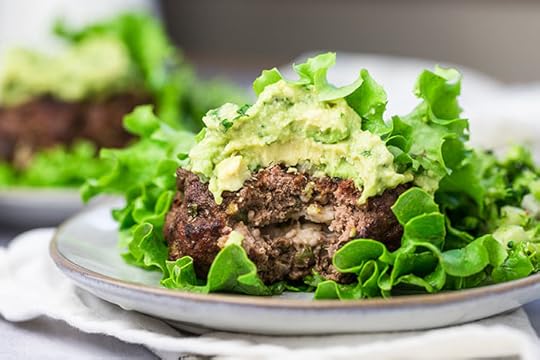 Serves: 6
Serves: 6
Time in the kitchen: 30 minutes
IngredientsGuacamole2 avocadosjuice from 1 lime1/3 cup chopped cilantro1/4 cup minced red onion2 Tbsp. finely chopped green pepper1/2 tsp. ground coriandersaltBurgers2 lbs. ground beef1/4 cup chopped cilantro2 tsp. chili powder2 Tbsp. minced red onion2 Tbsp. finely chopped green pepper2 tsp. ground cumin1 tsp. salt1 tsp. garlic powder1/2 tsp. black pepper4 oz. shredded cheddar, pepper jack or colby cheesegreen leaf or boston lettuceunsweetened BBQ sauce or spicy ketchup (optional)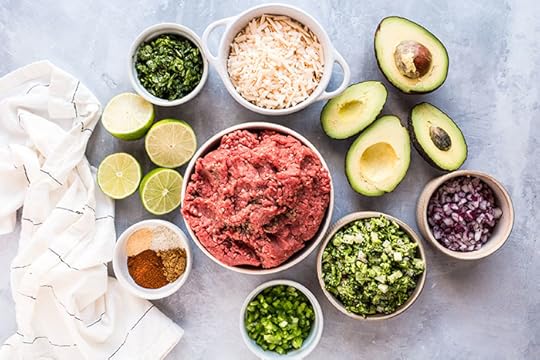 Directions
DirectionsPreheat your grill to medium-high heat.
In a bowl, combine the ground beef, spices, cilantro, red onion and green pepper.
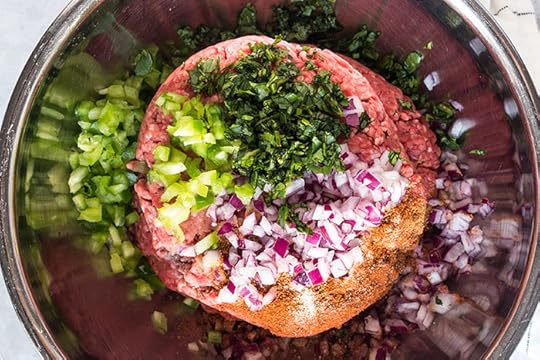
Form into 6 balls.
Take each of the balls and split them in half. Form one half into a flat patty with a slight indent in the middle and put a handful of shredded cheese in the center.
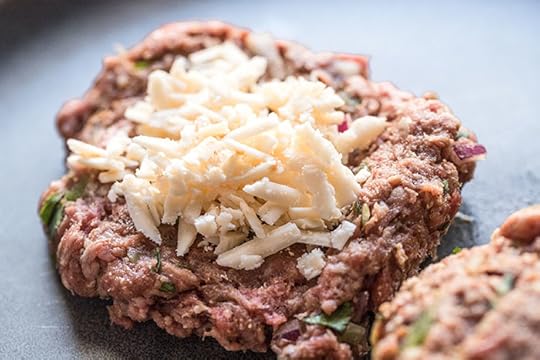 Take the other half of the patty and flatten it. Place the flattened patty on top of the stuffed patty and press the edges together to form one uniform stuffed patty. Repeat with the remaining meat and cheese. Make sure the edges are tightly pressed together to keep the cheese inside while grilling.
Take the other half of the patty and flatten it. Place the flattened patty on top of the stuffed patty and press the edges together to form one uniform stuffed patty. Repeat with the remaining meat and cheese. Make sure the edges are tightly pressed together to keep the cheese inside while grilling.
Place the burgers on the grill and cover. Allow to grill for 2 minutes, then turn them 90 degrees to form nice square grill marks.
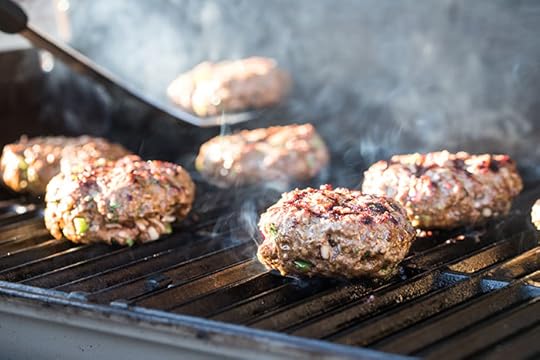 Grill for an additional couple of minutes, then flip the burgers over and repeat on the other side. Grill until the internal temperature reaches 160 degrees Fahrenheit. Remove the burgers from the grill and allow them to rest while you prepare the guacamole.
Grill for an additional couple of minutes, then flip the burgers over and repeat on the other side. Grill until the internal temperature reaches 160 degrees Fahrenheit. Remove the burgers from the grill and allow them to rest while you prepare the guacamole.
Scoop the flesh out from the avocados and mash with the lime juice until it reaches your desired texture. Stir in the onion, cilantro, pepper and coriander. Season with salt.
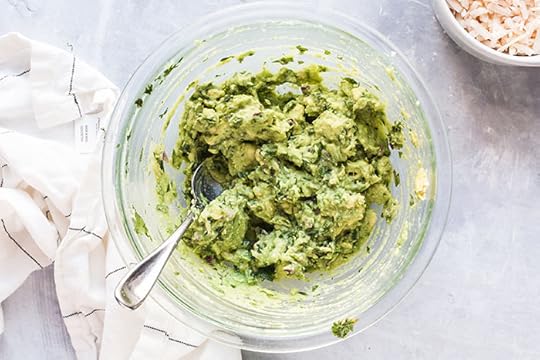
Place a dollop of guacamole on the burgers. Enjoy the burgers as-is or wrap them in lettuce.
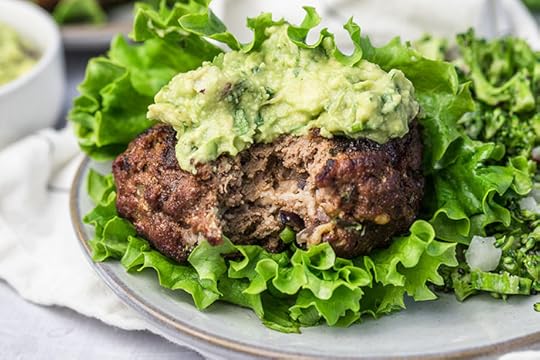
 Take it a step further with your favorite unsweetened BBQ sauce or spicy ketchup if you’d like! We like serving the burgers alongside our chopped broccoli salad.
Take it a step further with your favorite unsweetened BBQ sauce or spicy ketchup if you’d like! We like serving the burgers alongside our chopped broccoli salad.
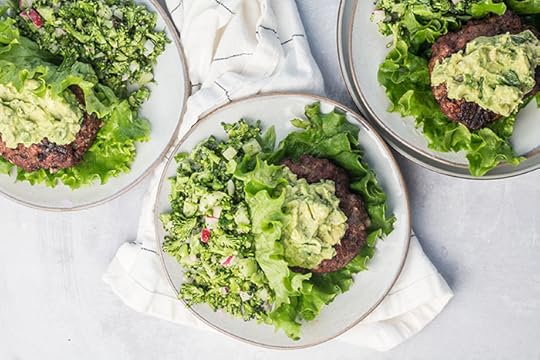
(function($) { $("#dftuTYY").load("https://www.marksdailyapple.com/wp-ad..." ); })( jQuery ); 
 Guacamole-Stuffed Southwest Burgers Author: Mark's Daily Apple
Guacamole-Stuffed Southwest Burgers Author: Mark's Daily Apple  Prep Time: 15
Prep Time: 15  Cook Time: 15
Cook Time: 15  Total Time: 30 minutes
Total Time: 30 minutes  Yield: 6 servings Diet: Gluten Free
Yield: 6 servings Diet: Gluten Free  Print Recipe
Print Recipe  Pin Recipe Description
Pin Recipe Description Cheddar-stuffed southwest spiced burger topped with cool guacamole and wrapped in lettuce.
Ingredients Guacamole2 avocados
juice from 1 lime
1/3 cup chopped cilantro
1/4 cup minced red onion
2 tbsp. finely chopped green pepper
1/2 tsp. ground coriander
salt
Burgers2 lbs. ground beef
1/4 cup chopped cilantro
2 tsp. chili powder
2 tbsp. minced red onion
2 tbsp. finely chopped green pepper
2 tsp. ground cumin
1 tsp. salt
1 tsp. garlic powder
1/2 tsp. black pepper
4 oz. shredded cheddar, pepper jack or colby cheese
Green leaf or boston lettuce
InstructionsPreheat your grill to medium-high heat.
In a bowl, combine the ground beef, spices, cilantro, red onion and green pepper.
Form into 6 balls.
Take each of the balls and split them in half. Form one half into a flat patty with a slight indent in the middle and put a handful of shredded cheese in the center.
Take the other half of the patty and flatten it. Place the flattened patty on top of the stuffed patty and press the edges together to form one uniform stuffed patty. Repeat with the remaining meat and cheese. Make sure the edges are tightly pressed together to keep the cheese inside while grilling.
Place the burgers on the grill and cover. Allow to grill for 2 minutes, then turn them 90 degrees to form nice square grill marks.
Grill for an additional couple of minutes, then flip the burgers over and repeat on the other side. Grill until the internal temperature reaches 160 degrees Fahrenheit. Remove the burgers from the grill and allow them to rest while you prepare the guacamole.
Scoop the flesh out from the avocados and mash with the lime juice until it reaches your desired texture. Stir in the onion, cilantro, pepper and coriander. Season with salt.
Place a dollop of guacamole on the burgers. Enjoy the burgers as-is or wrap them in lettuce.
Take it a step further with your favorite unsweetened BBQ sauce or spicy ketchup if you’d like! We like serving the burgers alongside our chopped broccoli salad.
 Category: Lunch, Dinner
Category: Lunch, Dinner Method: Grilling
Method: Grilling Cuisine: American Nutrition Serving Size: 1 burger Calories: 487.7 Sugar: .9 g Sodium: 673.9 mg Fat: 35.7 g Saturated Fat: 14 g Unsaturated Fat: 16 g Trans Fat: 1.3 g Carbohydrates: 7.8 g Fiber: 3.8 g Protein: 33.8 g Cholesterol: 124.3 g Net Carbs: 3.87 g
Cuisine: American Nutrition Serving Size: 1 burger Calories: 487.7 Sugar: .9 g Sodium: 673.9 mg Fat: 35.7 g Saturated Fat: 14 g Unsaturated Fat: 16 g Trans Fat: 1.3 g Carbohydrates: 7.8 g Fiber: 3.8 g Protein: 33.8 g Cholesterol: 124.3 g Net Carbs: 3.87 g Keywords: stuffed burger recipe, cheese stuffed burger recipe, cheddar stuffed burger recipe, guacamole burger recipe, southwest burgers recipe
 Did you make this recipe?
Did you make this recipe? Share a photo and tag Mark's Daily Apple — we can't wait to see what you've made!
Nutrition Facts (1 burger, 1/6 of guacamole)
Calories: 487.7
Sugar: .9g
Sodium: 673.9mg
Fat: 35.7g
Saturated Fat: 14g
Monounsaturated Fat: 14.32
Polyunsaturated Fat: 1.58
Trans Fat: 1.3g
Carbs: 7.8g
Net Carbs: 3.87g
Fiber: 3.9g
Protein: 33.8g
Cholesterol: 124.3mg
(function($) { $("#dfpgnPE").load("https://www.marksdailyapple.com/wp-ad..." ); })( jQuery ); 
The post Guacamole-Stuffed Southwest Burgers appeared first on Mark's Daily Apple.



May 21, 2021
New and Noteworthy: What I Read This Week — Edition 131
 Research of the Week
Research of the WeekAnother study confirming that selenium status is a strong factor in COVID severity.
“Dietary saturated fats seem to be less harmful than the proposed alternatives.”
Can parents with differing views on veganism compromise when feeding their kids?
The pandemic running boom. Who’s running and why?
Where does the lead hypothesis stand?
New Primal Blueprint PodcastsEpisode 493: Vanessa Lambert: Host Elle Russ chats with Vanessa Lambert, co-founder of Bee the Wellness, curator of incredible wellness retreats, and powerful purveyor of inside-out full body and mind health.
Episode 494: Jake Steiner: Host Brad Kearns chats with Jake Steiner about curing your myopia naturally.
Health Coach Radio: Erin and Laura chat with Dr. Kim Foster about the power of building a referral-friendly business.
Media, SchmediaIs there a sexual counter-revolution coming?
Civilization is way older than we think.
Interesting Blog PostsCatching natural selection in the act.
Social Notes
Next time you hear someone say “low-carb increases mortality…”
Everything ElsePeople are already experimenting with this parasite. You know they are.
Things I’m Up to and Interested InTerrible results: Overweight and obese COVID patients lose lean mass during their hospital stay and gain a bunch of visceral fat once they’re out.
More of this, please: Reintroducing the European bison into Spain to keep wildfire tinder down.
Important reminder: We’re still discovering new biomolecules.
Interesting article: Mushroom brain.
Want autophagy? Try keto: Nutritional ketosis upregulates hepatic autophagy.
Question I’m AskingWhat does summer mean to you?
Recipe CornerKeep garlic confit on hand.A good Cobb salad is hard to beat.Time CapsuleOne year ago (May 15 – May 21)
The Definitive Guide to Collagen — All about it.A to Z Microworkouts to Weave Into Your Day— How to keep moving and make it interesting.Comment of the Week
“pfffft privileged ancient pacific coast dwellers….”
-With that much wild Pacific salmon on their hands, they honestly were.
(function($) { $("#df9iWgL").load("https://www.marksdailyapple.com/wp-ad..." ); })( jQuery ); 
The post New and Noteworthy: What I Read This Week — Edition 131 appeared first on Mark's Daily Apple.



Mark Sisson's Blog
- Mark Sisson's profile
- 199 followers



